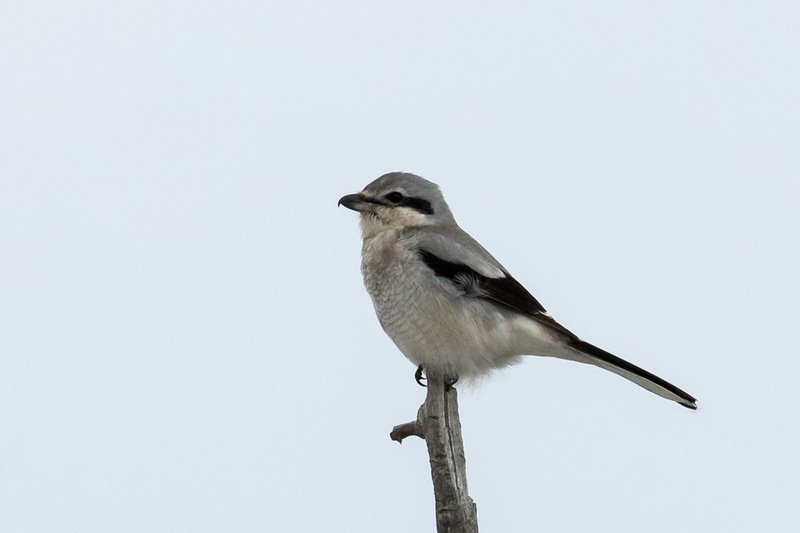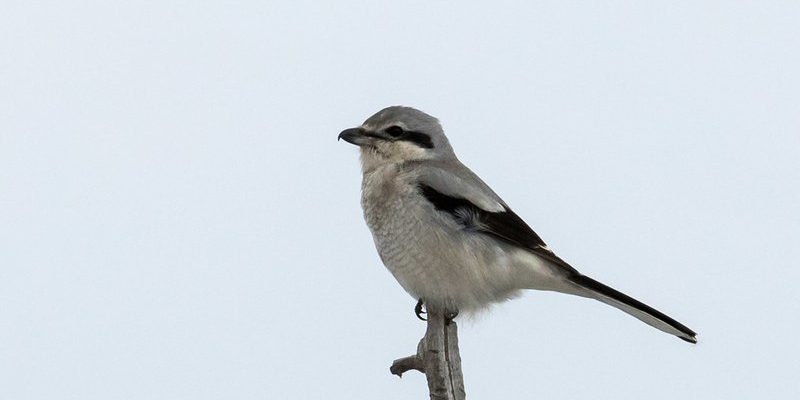
The Northern Shrike is one fascinating bird that seems to combine the charm of a songbird with the cunning of a raptor. Imagine a tiny, feathered predator that has a knack for catching prey much larger than itself. This bird is not just about looks; its hunting techniques and behaviors reveal a complex and interesting life. If you’ve ever seen a bird perched on a branch, looking fierce and determined, chances are it was a Northern Shrike.
Known for its unique habits and striking appearance, the Northern Shrike is a bird that attracts attention—from bird watchers to casual nature lovers. With a sharp beak and a bold personality, this little hunter is often referred to as a “butcher bird” due to its habit of impaling prey on thorns or barbed wire. It’s a true survivor in several habitats, showcasing adaptability in its quest for survival. Let’s explore what makes the Northern Shrike so special.
Physical Characteristics
The Northern Shrike is often described as a compact bird with a distinctive look. Adults are generally around 7 to 9 inches long, with a wingspan of about 12 to 15 inches. Their plumage varies slightly depending on the season, but you can typically spot them with a striking gray body, black mask-like markings around their eyes, and white underparts. The contrast makes them easily recognizable.
What truly sets them apart, however, is their bill. The Northern Shrike has a hooked beak, similar to that of a hawk, which is ideal for grasping and tearing into their prey. Their sharp talons help them catch small mammals, birds, and even insects, making them versatile hunters. The males and females look pretty similar, but males are usually a bit brighter, particularly during the breeding season.
Habitat and Range
You might be surprised to learn that the Northern Shrike is found in a variety of environments. This adaptable bird prefers open woodlands, shrublands, and even agricultural areas. They thrive in regions with plenty of perches to survey their surroundings. Their range extends across North America, from Canada to parts of the northern United States, particularly during the winter when they migrate southward looking for food.
During the breeding season, Northern Shrikes typically return to their northern territories. Here, they can find adequate nesting sites, often in dense shrubs or small trees. Their ability to adjust to various habitats is a testament to their resilience, allowing them to thrive in both urban and rural areas.
Diet and Hunting Behavior
The term “butcher bird” comes from their unique and somewhat gruesome feeding habits. The Northern Shrike primarily feeds on small mammals, such as voles, but they also catch birds and insects. What you might find particularly fascinating is how they hunt. They’ll often perch quietly, scanning the ground for movement before swooping down to catch their unsuspecting prey.
After making a catch, the Northern Shrike might not eat immediately. Instead, it often impales its prey on thorns or barbed wire—this behavior not only secures the food but also helps it tear apart the animal when it’s ready to eat. It’s a bit macabre but effective! This strategy allows the bird to store food for later consumption, especially when hunting is more challenging.
Breeding and Nesting
During the breeding season, typically from May to July, the Northern Shrike sets about creating a nest. The female is primarily responsible for nest building, choosing a concealed spot in dense foliage for protection. The nests are usually made of twigs, grasses, and other plant materials, creating a cozy environment for her eggs.
After laying around 5 to 7 eggs, the female incubates them for about 10 to 15 days, while the male brings food to her. Once the chicks hatch, both parents work together to feed them. It’s quite a sight to see the attentive parents darting back and forth, providing for their hungry brood. Within a few weeks, the chicks fledge and start to learn how to hunt, following their parents as they explore their territory.
Migration Patterns
Northern Shrikes are known to be migratory, with their movements largely influenced by food availability. As winter approaches, they will often move southwards in search of warmer climates and abundant food sources. Their migration isn’t as predictable as some other birds; it can vary greatly each year depending on environmental factors.
During migration, you might spot Northern Shrikes in smaller flocks, but they also maintain their solitary behavior while hunting. Some individuals may not migrate at all if they find adequate food supplies in their breeding grounds, showcasing their adaptability to changing conditions.
Conservation Status
The Northern Shrike is currently classified as a species of “Least Concern” by conservation authorities. However, like many birds, they face threats from habitat loss and changes in land use. Their reliance on specific habitats makes them vulnerable if those areas are altered or destroyed.
Conservation efforts are essential to ensure that Northern Shrikes continue to thrive. Preserving their natural habitats and creating awareness about the importance of birds in our ecosystems can help maintain their populations. Plus, keeping an eye out for these unique birds during your nature walks can contribute to citizen science, providing valuable information about their distribution and behavior.
Interesting Facts About the Northern Shrike
| Fact | Details |
|---|---|
| Size | 7 to 9 inches in length, 12-15 inches wingspan |
| Diet | Small mammals, birds, and insects |
| Habitat | Open woodlands, shrublands, agricultural areas |
| Breeding Season | May to July |
| Eggs | 5 to 7 eggs per clutch |
| Conservation Status | Least Concern |
Behavior and Social Structure
While Northern Shrikes are primarily solitary, they do exhibit some interesting social behaviors. They are known for their territoriality, especially during the breeding season when they defend their nesting areas vigorously. Males often sing to establish their territory and attract mates, showcasing their strength and vitality.
In some instances, Northern Shrikes may be seen interacting during migration or in places where food is abundant. Despite their solitary nature, these interactions can provide fascinating insights into their social structures. Observing a group of these birds can be an exciting experience, especially when they engage in their playful, yet predatory, antics.
Human Interaction and Cultural Significance
The Northern Shrike has captured the imagination of many cultures. Its unique hunting methods and striking appearance make it a popular subject for birdwatchers and photographers. In some regions, it is also incorporated into local folklore and stories, symbolizing cunning and resourcefulness.
Aside from cultural significance, these birds play important roles in ecosystems by controlling rodent populations. Encouraging the presence of Northern Shrikes in our backyards can benefit local environments, as they help maintain the delicate balance of nature. Plus, having the chance to observe these fascinating creatures can enhance your appreciation for wildlife.
FAQ
What does a Northern Shrike sound like?
The Northern Shrike has a variety of vocalizations that range from sharp, abrupt calls to melodious notes. Their songs can be somewhat varied based on the individual and the context. Listening to their calls can be quite enjoyable and adds to the excitement of spotting one in nature.
Are Northern Shrikes aggressive?
While they are not typically aggressive toward humans, Northern Shrikes are highly territorial during the breeding season. Males may exhibit aggressive behavior to defend their nesting sites against other birds, making them appear fierce. Their predatory nature also means they can be quite formidable among their prey.
What is the lifespan of a Northern Shrike?
The lifespan of a Northern Shrike in the wild is generally around 3 to 5 years, though some individuals can live longer under the right conditions. Factors like food availability, predation, and environmental conditions play significant roles in determining their lifespan.
Can Northern Shrikes be found in urban areas?
Yes, you can often find Northern Shrikes in urban areas, especially if there are suitable habitats nearby. They adapt well to various environments, and urban landscapes can offer ample hunting opportunities. Keeping an eye out for them in parks or green spaces can lead to exciting sightings.
How can I attract Northern Shrikes to my backyard?
To attract Northern Shrikes, consider creating a well-structured garden with native plants that provide shelter and food sources. Offering fruits, seeds, and water can help draw them in. Additionally, ensuring an open space for perching and hunting will make your backyard more appealing.
Do Northern Shrikes migrate alone or in flocks?
Northern Shrikes are mostly solitary during migration, although they may be seen in small groups where food is plentiful. Their migratory patterns can vary yearly, and individual birds often choose to go it alone in search of the best feeding grounds.
What role do Northern Shrikes play in their ecosystem?
Northern Shrikes play a crucial role in controlling rodent populations, as they prey on various small mammals. By managing these populations, they help maintain balance in their ecosystems. Their eating habits also contribute to the health of the environment by preventing overpopulation of certain species.
Are Northern Shrikes protected?
While Northern Shrikes are classified as a species of “Least Concern,” they still benefit from habitat protections and conservation efforts. Awareness and support for habitat preservation can help ensure that these unique birds thrive in the wild.
What is the best time of year to see Northern Shrikes?
The best time to spot Northern Shrikes is during fall and winter when they migrate southward. You’ll have a higher chance of encountering them in open areas where they hunt for food. Their distinctive appearance and behaviors make them easier to identify during this time.
How can I identify a Northern Shrike from other birds?
To identify a Northern Shrike, look for its stout body, hooked beak, and characteristic black mask around the eyes. Their gray plumage, along with their behavior of perching on exposed branches or wires, can help distinguish them from other birds in similar habitats.

